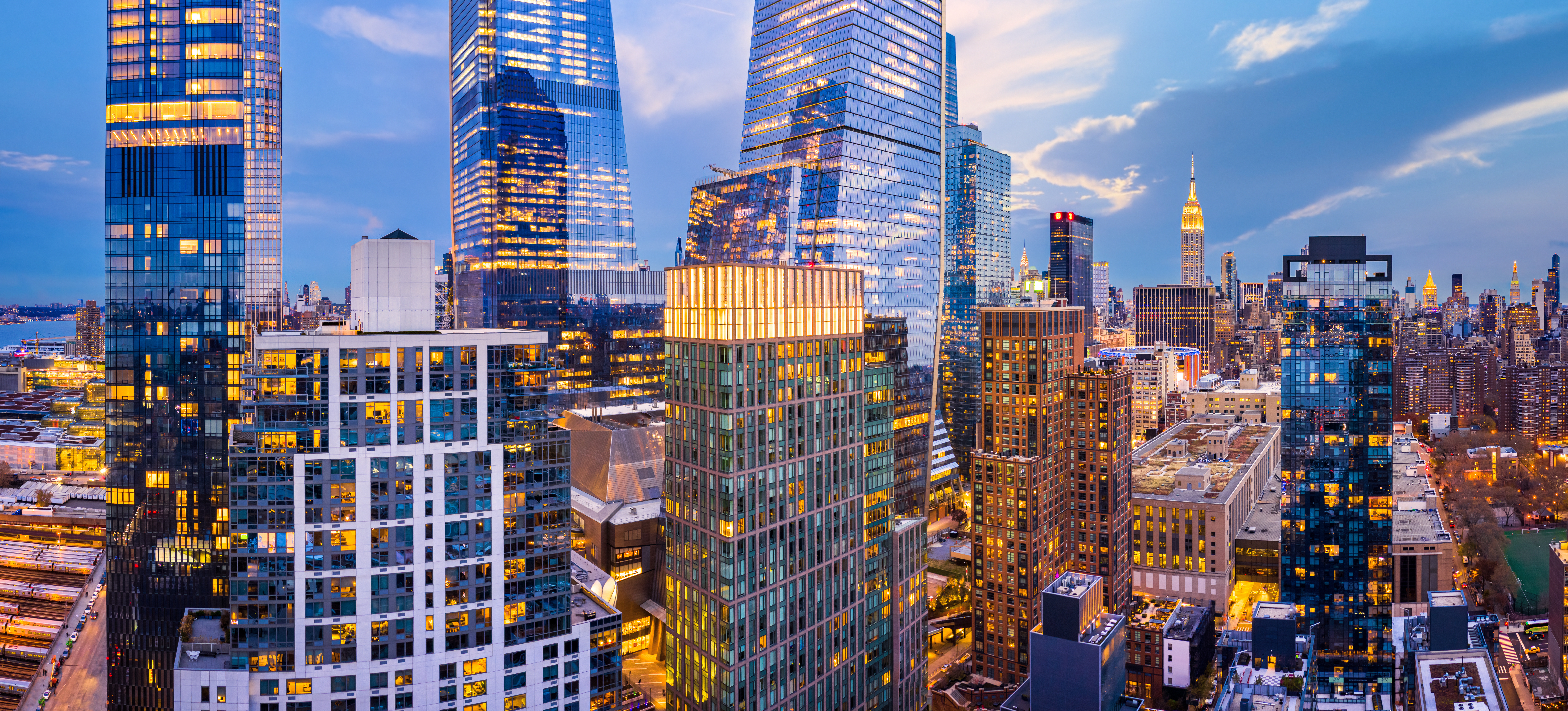Everything You Need to Know about New York’s Historic Legislation on Building Emissions.
On May 19, 2019, the New York City Council passed local law 97 (LL 97) as the centerpiece of the city’s Climate Mobilization Act (CMA), which plans to reduce citywide carbon emissions by 40 percent by 2030 and 80 percent by 2050. LL 97 recognizes both that the city’s buildings are the single largest contributor to greenhouse gas (GHG) emissions, accounting for nearly 70 percent of total citywide emissions in 2014, and that the technology and know-how exist today to enable the city to reach its ambitious emissions reduction targets. At Atrius, our mission is to empower building managers to boost efficiency and cost savings through an intelligent, intuitive building energy management platform, so we’d like to spend some time talking about the impact of Local Law 97.
What NYC’s Local Law 97 Means for Building Owners And Managers
Local law 97 is a complex piece of legislation that introduces increasingly stringent limits on carbon emissions for covered buildings. Beginning in 2024, buildings over 25,000 square feet or tax lots with two or more buildings collectively exceeding 50,000 square feet will be expected to comply. The law affects more than 57,000 buildings across the city, aiming to reduce citywide building-based emissions by 40 percent by 2030.
The new limits are fairly aggressive and are structured into two initial compliance periods: one from 2024-2029 and the other from 2030-2024. While specific limits vary based on the type of building, most buildings will need to reduce carbon emissions per square foot by roughly 50 percent from one period to the next.
So what does this mean for building owners and managers? The first step is understanding your building’s current carbon emission footprint. This can be calculated by using the free US EPA’s Energy Star Portfolio Manager, which calculates building emissions data based on energy usage. Understanding your current level will show you how significantly you’ll need to reduce emissions to avoid potentially steep penalties after the compliance period comes into effect in 2024. While penalties can be significant, the first compliance period targets the city’s least efficient buildings such that many buildings will not be subject to fines until the second compliance period.
What Do I Need to do in Order to Comply with LL 97?
Compliance with LL 97 requires building owners to ensure that the carbon emissions from their building(s) are lower than the carbon emissions intensity limits set by the city during a given compliance period. LL 97 additionally requires building owners to submit annual reports regarding compliance. The first compliance period runs from January 1, 2024 through the end of 2029, with the first compliance report due on May 1, 2025. Here are steps that you can take in order to comply with LL 97:
1. Understand Your Building Emissions
Building emissions include the greenhouse gas emissions, expressed in metric tons of carbon dioxide equivalent, that are emitted as a result of operating a building. The calculation of building emissions, therefore, considers the amount of energy consumed by the building, the source of that energy, and the time of consumption. Luckily, most NYC buildings greater than 25,000 GSF (i.e. those required to comply with LL 97) are already using Energy Star Portfolio Manager to report on building energy consumption as required by LL 84, the city’s energy benchmarking ordinance. Energy Star Portfolio Manager will calculate your emissions based on the consumption data that you have entered. This emissions calculation can be used with respect to LL 97; however, it is important to note that you will need to convert the units from kilograms of carbon dioxide equivalent (KgCO2e), as calculated by Energy Star, to metric tons of carbon dioxide equivalent (mtCO2e) as required by LL 97. Our energy management software can help to automate the process by normalizing and converting the data for you and push it directly to Energy Star.

2. Determine Whether Your Building Emissions Exceed The Applicable Emissions Limit
Once you have calculated your building emissions, you will need to compare that value against the applicable emissions limit for your building. Emissions limits depend on the occupancy classification of the building and have been predetermined for the first two compliance periods. Use the following table to identify the applicable emissions limit for your building.
| Occupancy Classification | Emissions Limit (KgCO2e/sf) 2024-2029 | Emissions Limit (KgCO2e/sf) 2030-2024 |
| A – Assembly: Non-residential space used to gather for civic, social, recreational, and religious functions | 10.74 | 4.2 |
| B – Business: Space used for business offices | 8.46 | 4.53 |
| B (Business Subset): Civic AdministrativeH – High Hazard: Structures used for processing, generating or storing hazardous materials I-2 – Ambulatory Health Facilities: Medical offices, hospitals, and spaces other used for surgical, psychiatric, nursing or other personal careI-3 – Restrained Housing: Jails, detention centers, mental hospitals | 23.81 | 11.93 |
| E – EducationalI-4 – Custodial Care Facilities | 7.58 | 3.44 |
| I-1 Adult Homes, Enriched Housing Facilities | 11.38 | 5.98 |
| F – Factory and Industrial | 5.74 | 1.67 |
| M – Mercantile: Space used for display and/or sale of merchandise including retail, wholesale, and showrooms | 11.81 | 4.03 |
| R-1 – Transient Residential: Spaces generally occupied for less than one month including hotels, motels, and vacation time shares | 9.87 | 5.26 |
| R-2 – Residential | 6.75 | 4.07 |
| S – Storage: Storage facilities U – Utility: Utility structures such as carports | 4.26 | 1.10 |
3. Assess the Penalty for Non-Compliance to Guide Compliance Strategy
Non-compliant building owners will be subject to a maximum civil fine equal to the difference between the building’s annual emissions limit and its actual emissions multiplied by $268.
For example, a 75,000 GSF commercial office building with 2024 emissions totaling 787,500 KgCO2e is not in compliance. This is because total actual emissions exceed the emissions limit for a building of this occupancy classification during the respective compliance period (Emissions Limit = 75,000 GSF * 8.46 KgCO2e/sf = 634,500 KgCO2e). Accordingly, the building owner is subject to a civil fine of $41,004.00 (787,500 KgCO2e – 634,500 KgCO2e * $268.00 / 1,000 = $41,004.00)
It is important to note that additional penalties apply for failing to submit the annual compliance report and for submitting false reports. The penalty for failing to submit a timely compliance report is $0.50 per GSF per month that the report is not submitted. Submitting a false report constitutes a misdemeanor and may subject the building owner to a $500,000.00 fine and up to 30 days in jail.
4. Evaluate Strategies for Compliance and Applicable Costs
There are two main avenues for compliance with LL 97. First, building owners can implement energy efficiency and/or savings measures to reduce emissions. Because the capital cost and time to implement various efficiency measures vary significantly, it is highly recommended that building owners begin assessing compliance with LL 97 now. Second, building owners can take advantage of deductions by (a) purchasing renewable energy credits (RECs), (b) GHG offsets, or (c) investing in clean distributed energy resources such as onsite solar PV.
If a building owner is not in compliance and good cause exists for believing that compliance will not be feasible prior to the first compliance period (i.e. 2024-2025), a building owner may apply for an adjustment to the building’s emissions limit. To qualify for an adjustment, the building must be in existence or construction must be permitted prior to November 15, 2019. If awarded, the adjustment is valid for up to 3 years. Applications for adjustments must be submitted prior to January 1, 2021.
5. Implement Low-Cost High Reward Strategies First
Before making large capital investments, consider low-cost high reward strategies to optimize building performance through occupant engagement and behavioral change programs.
What if I am Already in Compliance?
Remember, emissions limits will become more stringent over time. Just because you are in compliance now, does not mean that the same will hold true for future compliance periods. Additionally, LL 97 has tasked the Mayor’s Office with studying and implementing a carbon trading program by January 1, 2021. If implemented, building owners may be able to take advantage of a new source of income by capitalizing on the success of existing or continued efficiency measures.
There is no doubt about it, LL 97 will significantly change the way NYC buildings are occupied, operated, and maintained. With climate change occurring at an unprecedented rate, NYC is taking aggressive and commendable action by targeting its building stock – the greatest contributors to citywide emissions.
Unlock Savings & Efficiency with Our Commercial Building Energy Management Software
There are many ways to reduce energy usage and carbon emissions to help comply with Local Law 97, but perhaps one of the most important steps is fully understanding your current energy usage – and that’s where we come in. Atrius offers comprehensive software platforms that centralize many different streams of building and energy usage data, allowing you to understand and act on data to improve operational efficiency and reduce energy consumption.
